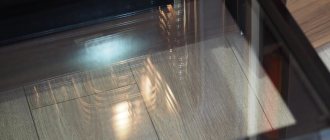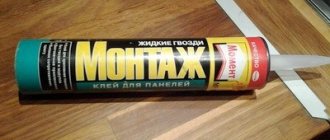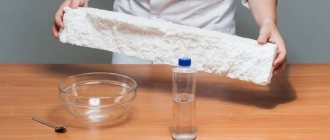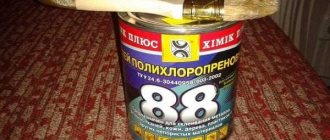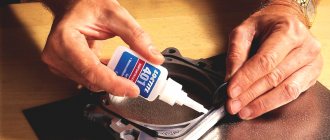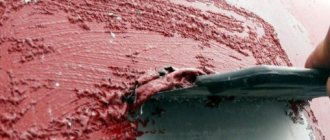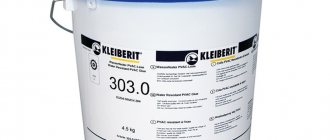Types of glass glue
We recommend the following adhesive options:
- Glass adhesive Done Deal , which is also used for repairing headlights, brake lights, car hatches, sidelights, and plastic body parts.
- Unique.
- BF-2.
- The ideal glass glue has a thick, viscous composition, without color, but with a specific odor.
- It is convenient to apply.
- It sets quickly.
- Safe for humans, easy to use, non-explosive and non-flammable.
Let's look at the popular types of glue for working with glass surfaces
- The Done deal repair kit is well known to car enthusiasts and auto repair shop workers. This is a ready-made set of products for eliminating chips and cracks on the windshield, as well as on glass and plastic car headlights. The glue is ready to use and does not require mixing the ingredients.
The composition is acrylic acid, methacrylic acid ester with additives. The glue is transparent, sets in half an hour, and hardens in 1 hour.
- restores the optical properties and transparency of glass,
- allows you to increase the strength of the damaged area,
- removes chips up to 20 mm in size,
- prevents cracks from growing.
Cost – from 237 rubles.
- Unicum is a widely used waterproof adhesive that can be used to connect glass to metal. This is a one-component composition with chloroprene rubber and is a viscous liquid of beige or light green color. The resulting adhesive joint can withstand temperatures from -40C to +70C and is resistant to moisture. Polymerizes within 2 hours.
Cost – from 160 rubles.
- BF-2 – adhesive for bonding static materials – glass, wood, metal, ceramics, plastic. Used in everyday life and in restoration work. Not suitable for repairing dishes, as the product contains toxic aldehydes and phenol. The glue is universal, resistant to moisture and chemicals.
Cost – from 150 rubles.
- UHU Glas is a quick-setting transparent adhesive for working with crystal and glass. Not afraid of alkalis and acids, ultraviolet radiation, and high temperatures. Suitable for repairing car tinted and safety glass. Does not contain solvents, dries quickly, completely polymerizes within 24 hours.
Cost – from 220 rubles.
How to glue glass correctly
The question of how to properly glue glass is asked by many when a favorite vase or other object made of this fragile material accidentally breaks. Using modern adhesives, you can significantly extend the life of the product.
- Bonding glass to glass or other materials requires careful preparation of the surface, their precise installation and fixation under full external influence.
- The choice of a suitable adhesive depends on possible physical and chemical processes, operating conditions of the joint.
- Joining glass requires preliminary degreasing of the surface and cleaning of contaminants. You can degrease with alcohol, kerosene, gasoline, but more often use regular acetone.
- Among the most popular adhesive compositions, it is worth highlighting Unicum, Mars, BF-2.
- After degreasing, both surfaces are treated with adhesive and wait until it dries, about 10 minutes, then another layer is required, which will dry for 3 minutes.
- Next, the surfaces are connected. For a more precise and durable connection of parts, rubber bands are used. They are left for at least 20 minutes, and it takes about a day for the seam to completely harden.
- Wood, fabric or paper is glued to glass using PVA or PVA-A glue. The surfaces are treated with glue, connected, a weight is placed on top and left for 1-2 hours.
Bonding glass and metal surfaces is necessary for sealing window frames and aquariums. Two-component sealants are suitable for this, for example, Sealant PL-1, Elastosil-2, Unicum. They provide a reliable waterproof seam.
VIDEO ON THE TOPIC
How to glue glass to glass
Bonding glass requires the use of a special composition.
Here are some useful tips for choosing:
- select it taking into account the characteristics of the glass, its strength and other characteristics,
- a waterproof and transparent seam will help to obtain the compositions “Unicum” and “Phoenix”,
- silicone adhesives also provide transparency of the seam, but they are toxic,
- ultraviolet-based adhesive resin will help to fasten individual fragments tightly adjacent to each other,
- When repairing dishes, use non-toxic options.
- Wash surfaces thoroughly with soap and wipe dry.
- We apply UHU Glas to the edge of one of the surfaces in a small amount, then to the second surface and press the materials tightly against each other. They will fix within 2 minutes.
- Leave the items for a day until complete polymerization.
- Remove excess glue from the edges with a blade and wipe the glass.
UV glue for glass
The invention of ultraviolet glass adhesive occurred not so long ago. Its composition gives such a strong connection that if you break the surface, it will break anywhere, but not in the place of gluing. That is, it actually turns two parts into a single whole.
But reliability is not its only advantage. Compositions with acrylic polymers are transparent, and if you look at the seam in the light, it will seem that the glass parts are simply placed next to each other.
Read also: Route operational map example
Any UV requires exposure to the ultraviolet spectrum of light with a wavelength of at least 350 nm. This is not always convenient, since you constantly need to use a lamp or even several, but on the other hand, until you turn on the lamp, you don’t have to rush, since the composition itself will not harden.
It is necessary to comply with certain requirements for humidity, temperature, and degree of glass transparency.
Mixtures may differ from each other in degree of viscosity. The weakest means are suitable for fastening glass parts together; the strongest ones allow you to glue glass to wood, metal and other surfaces.
UV mixtures are classified into two groups: for transparent plastics and glass.
- In order for the glue to polymerize, a special powerful UV lamp is needed. The longer the UV rays needed to harden the mixture, the stronger the compound will be.
- For fastening with a minimum gap, a composition of medium viscosity or a gel-like version is suitable.
- High-quality, durable heat-resistant adhesives for UV glass allow you to solve a wide range of problems and are indispensable both in industry and in everyday life.
VIDEO DESCRIPTION
Optical glue for glass
Optical glass adhesives are widely used in industry. There are several varieties.
- Balsam is reliable in fastening centered lenses. At 80C it begins to turn yellow. Not suitable for fastening parts that have high demands on image quality.
- Balsam M - hardens at room temperature, so it is more convenient to use. Used when working with optical parts made of silicate glasses, as well as polaroids and filters.
- Acrylic optical adhesive - colorless, transparent or with a yellow tint. Suitable for connecting prisms and lenses up to 30 mm in size. After gluing, parts require long-term drying.
How to remove glue from glass
Most often, glue remains on glass from manufacturer labels or after repairs. Traces must be removed promptly; after a while it will be more difficult to do so.
When asked how to remove glue from glass , builders answer that you will need acetone, dishwashing liquid, ammonia, glass cleaner, and white spirit.
- Try the following solution: mix a small amount of dishwashing liquid and a tablespoon of 10% ammonia.
- Apply the product to the desired area and leave for an hour.
- Wet the stain periodically, and when the glue gets wet, remove the residue with a sharp object.
How to remove glue from glass
A very effective windshield wiper that can be purchased at any car store. All they have to do is treat the stain and remove it with a utility knife after a few minutes.
Gasoline will also work. Soak a cotton swab in it and apply it to the area with glue for ten minutes, then remove with a sharp object.
White spirit, nail polish remover, and acetone have similar properties.
You can remove fresh traces of PVC glue with a paper napkin, then wipe the area with a soft sponge. The treated area is polished with a towel and microfiber cloth.
After removing the glue, spray glass cleaner onto the glass and wipe dry with a cotton towel.
Glass is quite common in human everyday life. This material is used in construction. Furniture and interior items are made from it. Sometimes situations arise when you need to connect glass parts or glue glass to some other material. You can solve this problem by arming yourself with special glue. Such a substance should connect the glass parts firmly and not reduce their transparency.
How to glue glass to glass
It is not always possible to throw away a broken glass object and replace it with a new one.
The correct selection of glue and adherence to gluing technology will help extend the life of an aquarium, table, or window glass.
You can obtain a reliable and unnoticeable connection between glass and glass or other materials by using the adhesives listed in the table.
PVA
| Reliably glues not only paper, but also glass surfaces. When applying the composition, do not allow bubbles to appear. The surfaces to be joined must be kept under load for at least half an hour. As a result of polymerization, the glue becomes transparent. | |
| BF4 and BF2 | After application, the surfaces are dried and then pressed with maximum force. An ideal connection can be obtained by exposure to a temperature of the order of + 140 C; in practice, this condition is not always possible to fulfill. |
| Moment, or rather, Moment-Crystal | After drying it becomes more transparent. The surfaces with the applied glue are dried for 10-15 minutes, then they are connected using force. After a day, such a connection becomes stable and can withstand loads. |
| Based on cyanoacrylates, Strength, Second | They quickly form compounds. The disadvantage is the destruction of the structure when exposed to high temperatures (above + 80 C) and fracture loads. |
| Epoxy | Provides a strong connection due to polymerization. The inconvenience is the two-component nature of the glue, i.e. To obtain the required amount of the working substance, you will need to prepare a fresh mixture and maintain the exact dosage of the components. It hardens within a couple of hours; some types of epoxy require heating to completely harden. |
Read also: Homemade magnetic corner for welding
Adhesive for glass surfaces
It creates a completely transparent elastic seam that can withstand shear loads.
Room temperature is sufficient for the glue to harden. The setting process lasts about half an hour; the product can be subjected to loads after a day.
The connection will not be damaged by temperatures within + 200 C, acids or moisture.
Silicone glue cannot be used on mirror surfaces - it can dissolve the sprayed aluminum film.
